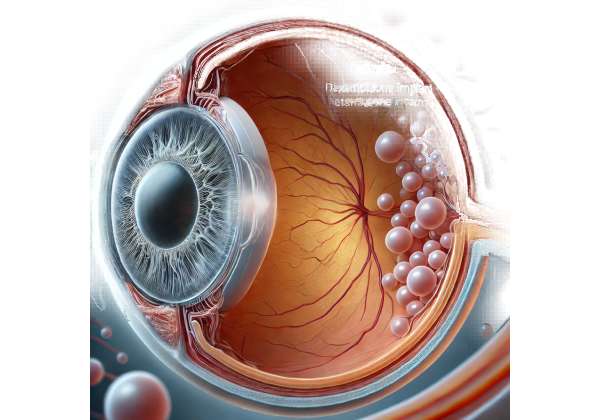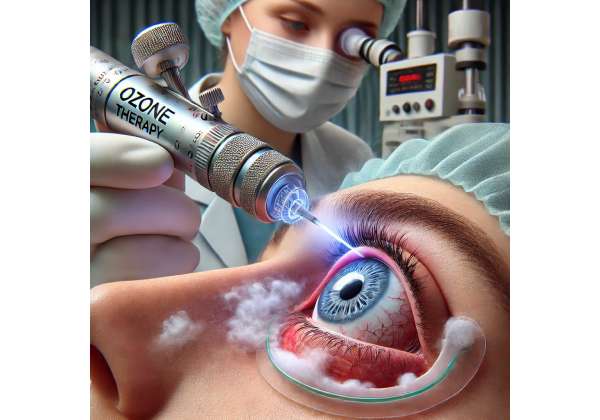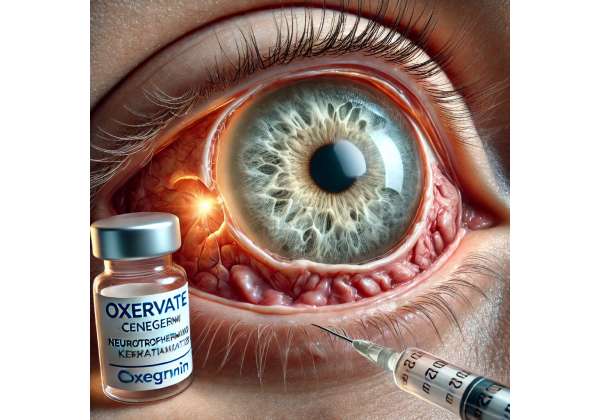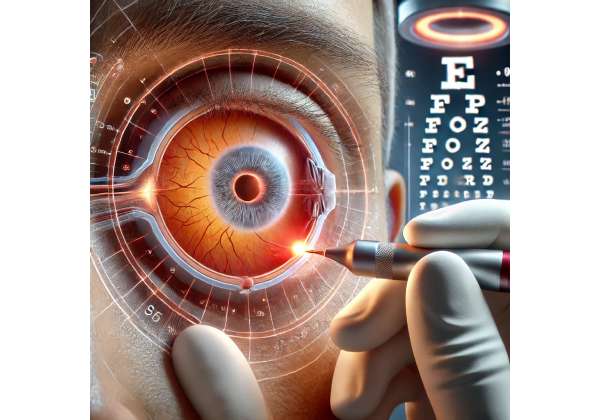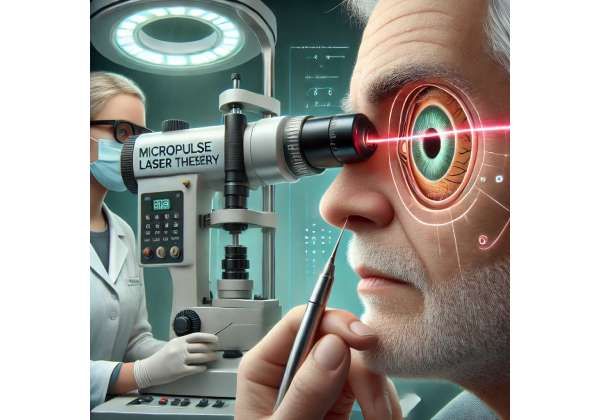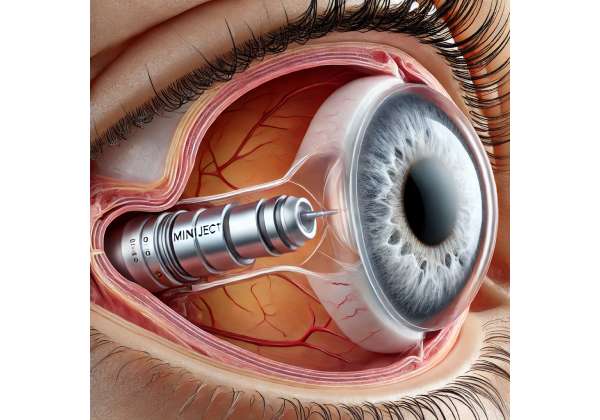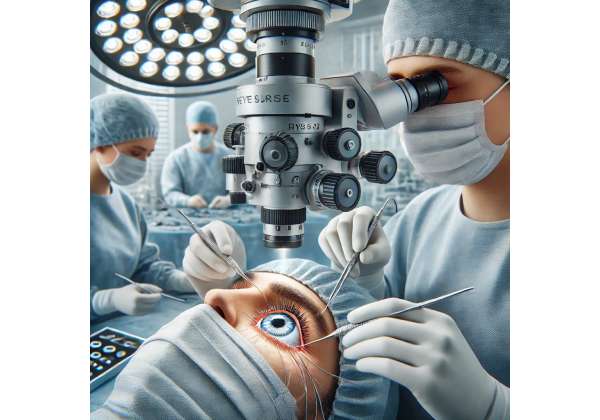Ozurdex (Dexamethasone Implant) Sustained Control of Diabetic Macular Edema with Reduced Retinal Inflammation
Diabetic macular edema (DME) is a significant cause of vision impairment among individuals with diabetes, and its management has long presented a clinical challenge. In the realm of ocular therapies, Ozurdex—a sustained-release dexamethasone implant—has emerged as an innovative solution that not only targets the underlying inflammation but also offers prolonged therapeutic control. By delivering a consistent dose of corticosteroid...
Ozone Therapy A Novel Solution for Refractory Corneal Infections
Ozone therapy is rapidly emerging as an innovative approach in the realm of ophthalmology, offering renewed hope for patients with refractory corneal infections. In today’s fast-evolving medical landscape, practitioners and patients alike are seeking treatments that not only target stubborn infections but also promote healing through multi-faceted mechanisms. Ozone therapy stands out by harnessing the potent oxidizing power of...
Oxysterol-Based Drugs in Phase 3 Eye Drops Poised to Reverse Cataract Progression
Innovative treatments are continuously reshaping the landscape of ophthalmology, and one of the most exciting developments on the horizon is the emergence of oxysterol-based drugs formulated as eye drops. Currently in Phase 3 clinical trials, these novel formulations hold promise for reversing cataract progression—potentially offering a non-surgical alternative that targets the underlying cellular mechanisms of lens opacification. With a...
Oxervate (Cenegermin) for Neurotrophic Keratitis Breakthrough in Corneal Healing
Imagine a therapy that not only alleviates chronic eye discomfort but also actively promotes true corneal healing. Oxervate (cenegermin) is that breakthrough—an innovative treatment designed to address neurotrophic keratitis by stimulating the natural healing process of the cornea. Instead of merely masking symptoms, Oxervate works at a cellular level to restore the health of the corneal nerves, thereby enhancing...
Orthokeratology for Myopia Control How Ortho-K Lenses Help Children
Is your child struggling with progressive myopia, also known as nearsightedness? Orthokeratology—often called “Ortho-K”—may be the pivotal solution you’ve been seeking. These specially designed contact lenses are worn overnight to gently reshape the cornea, offering clear daytime vision without glasses or daytime contact lenses. More importantly, Ortho-K has gained significant recognition for its ability to slow or even halt...
Ortho-K Lenses for Astigmatism A Non-Surgical Vision Correction Solution
If you’re seeking a non-surgical path to sharper vision without relying on daytime glasses or contact lenses, orthokeratology—often shortened to “Ortho-K”—might be the answer. It’s an approach that uses specially designed rigid contact lenses worn overnight to gently reshape the cornea. Although Ortho-K is traditionally known for myopia control, innovations in lens design now make it a compelling option...
Orphan Gene Therapy for PDE6B Mutation New Targeted Therapy for Rare Genetic Forms of Retinitis Pigmentosa
Have you ever wondered if cutting-edge science could rescue vision in people living with a rare genetic eye disease? That’s exactly what investigators hope to accomplish with a novel gene therapy targeting PDE6B—a gene often associated with certain forms of retinitis pigmentosa (RP). Rather than merely slowing down damage to the retina, researchers are aiming to restore or preserve...
Optogenetics Restoring Vision for Advanced Glaucoma Patients with Innovative Therapies
Are you looking for a forward-thinking solution that could potentially restore some degree of sight in advanced glaucoma patients? Optogenetics might just be the breakthrough. Originally developed within neuroscience to map and control neurons using light-activated proteins, optogenetics now offers a promising strategy for degenerative eye diseases. By genetically modifying certain retinal cells to respond to specific wavelengths of...
OpRegen RPE Transplants for Dry AMD How This Innovative Therapy Restores Vision
Imagine a therapy that replaces the deteriorating cells in your retina and potentially halts—maybe even reverses—the vision loss in dry age-related macular degeneration (AMD). That’s exactly the promise behind OpRegen, a groundbreaking approach that involves transplanting healthy retinal pigment epithelium (RPE) cells into areas affected by the advanced atrophic form of AMD. Instead of relying on drugs or invasive...
Ocular Surface Regenerative Therapies How Amniotic Membrane Transplantation Heals Corneal Ulcers
When it comes to sparking true corneal rejuvenation, amniotic membrane transplantation (AMT) stands out as a powerful therapy for persistent ulcers. By leveraging the placenta’s natural wound-healing factors, this procedure brings new possibilities for patients who’ve tried conventional drops, patches, or even repeated surgeries without success. Far from an experimental niche, amniotic membrane therapy has evolved into a well-established...
Nevanac Speeding Recovery and Reducing Pain After Cataract Surgery with Advanced Nepafenac Therapy
Looking for an easier and more comfortable recovery from cataract surgery? Meet Nevanac, an innovative eye drop formulation designed to address the most common postsurgical issues—pain, inflammation, and delayed healing. By harnessing the power of nepafenac, Nevanac offers a nonsteroidal anti-inflammatory (NSAID) approach that targets the eye’s inflammatory pathways without relying on corticosteroids alone. Compared to older-generation NSAIDs, nepafenac...
Neurostimulation Devices for Dry Eye Disease How TrueTear Stimulates Natural Tear Production
If you’ve ever wished there were a way to produce more of your own natural tears—without the constant cycle of eye drops—TrueTear may be the solution you’re looking for. This handheld neurostimulation device taps into your body’s innate tear-producing mechanisms, targeting the nerves that help lubricate the eyes naturally. Rather than masking discomfort with topical agents, TrueTear addresses the...
Neuroprotective Laser Therapy for Glaucoma Protecting Retinal Ganglion Cells and Preserving Vision
What if there were a technique capable of doing more than merely lowering intraocular pressure in glaucoma—something that actively helps safeguard the delicate retinal ganglion cells (RGCs) from ongoing damage? That’s exactly the premise behind neuroprotective laser therapy. By harnessing specific wavelengths and targeted energy levels, this innovative approach goes beyond conventional strategies, aiming to slow the progression of...
Nerve Growth Factor (NGF) The Revolutionary Approach to Healing Corneal Ulcers and Safeguarding the Optic Nerve
How incredible would it be if a single protein could promote faster healing of corneal ulcers and help preserve the vital optic nerve, all by harnessing the body’s natural regenerative capacities? Nerve Growth Factor (NGF) is making that possibility a reality. Originally renowned for its role in supporting the growth and maintenance of neurons, NGF has emerged as a...
Nano-Pulse Stimulation Therapy for Diabetic Retinopathy A New Approach to Retinal Health
Imagine harnessing the power of ultrashort electrical pulses to protect, preserve, or even enhance the health of your retina. For many individuals facing the challenges of diabetic retinopathy, this vision of a noninvasive, supportive therapy that requires no continuous drug regimen is particularly appealing. Nano-Pulse Stimulation (NPS) therapy aims to bring this possibility to life. By delivering precisely timed...
Nano-Pulse Stimulation for Age-Related Macular Degeneration A Cutting-Edge Vision Therapy
Are you looking for a forward-thinking vision therapy that goes beyond conventional injections and medications? Nano-Pulse Stimulation (NPS) might be the breakthrough you’ve been waiting for. By targeting retinal cells with precisely timed electrical pulses, NPS aims to preserve or even enhance visual function in people living with age-related macular degeneration (AMD). Instead of relying solely on standard therapies...
Multifocal and EDoF IOLs AcrySof IQ Vivity and Tecnis Eyhance Lenses for Enhanced Vision
Are you seeking a more seamless visual experience at multiple distances without relying heavily on glasses? Recent innovations in intraocular lenses (IOLs) have paved the way for clearer vision and greater independence after cataract surgery or refractive lens exchange. Two leading-edge options in this realm are the AcrySof IQ Vivity and Tecnis Eyhance lenses. These advanced lenses aim to...
MSC-Derived Exosomes in Dry AMD A New Approach to Preventing Retinal Cell Death
Dry age-related macular degeneration (AMD) is a complex eye condition that gradually diminishes central vision, making everyday tasks such as reading or recognizing faces increasingly difficult. While traditional treatment strategies have largely focused on nutritional supplementation, vision aids, and in some cases laser therapy, these measures often offer only modest protection against further vision loss. This has prompted a...
Molecular Hydrogen Therapy A Promising Solution for Optic Neuritis and Nerve Protection
Optic neuritis can appear unexpectedly, often manifesting as sudden blurred or lost vision, color desaturation, and discomfort around the eye. For many, these symptoms disrupt daily activities such as reading or navigating familiar spaces. While conventional treatments like corticosteroids aim to reduce inflammation and speed recovery, people diagnosed with optic neuritis—especially those with recurring flare-ups—often search for additional ways...
Molecular Hydrogen for Dry Eye Syndrome A Natural Approach to Ocular Surface Health
Dry eye syndrome affects millions of people worldwide, leading to symptoms such as irritation, grittiness, excessive tearing, and blurred vision. While over-the-counter lubricating drops or medicated ointments can offer temporary relief, many sufferers seek alternative therapies that address the root causes—often involving inflammation and oxidative stress. In recent years, molecular hydrogen (H₂) has entered the spotlight as a potential...
Minimally Invasive Micropulse Laser Therapy A New Approach to Improve Outcomes in Age-Related Macular Degeneration
Age-related macular degeneration (AMD) remains one of the primary causes of central vision loss worldwide, affecting millions of people who often struggle to maintain daily activities like reading, driving, or recognizing faces. Traditional treatments for AMD—ranging from dietary supplements to anti-VEGF injections—can help manage the condition, yet there is a growing demand for procedures that are less invasive and...
Miniject A Minimally Invasive, New Option for Glaucoma to Help Lower Eye Pressure
Glaucoma remains a leading cause of irreversible vision loss worldwide, prompting ongoing research into more refined and patient-friendly solutions. While established treatments—such as medicated eye drops, laser procedures, and surgical interventions—can help lower intraocular pressure (IOP), many individuals still seek better ways to preserve their sight with fewer side effects. This is where minimally invasive glaucoma surgery (MIGS) devices...
MicroRNA Therapies Targeting Glaucoma Progression at the Genetic Level
Glaucoma continues to be one of the most widespread causes of irreversible blindness across the globe, compelling both patients and healthcare professionals to seek innovative therapies that go beyond traditional medication and surgical procedures. The quest for a more targeted approach has led to heightened interest in microRNA treatments that can regulate gene expression involved in the onset and...
Micropulse Laser Therapy for Retinal Vein Occlusion Enhancing Vision Outcomes
Retinal vein occlusion (RVO) is a serious eye condition in which the veins responsible for draining blood from the retina become blocked, leading to swelling, fluid leakage, and potential vision loss. Depending on whether the main central vein or smaller branch veins are affected, RVO is categorized as central retinal vein occlusion (CRVO) or branch retinal vein occlusion (BRVO)....
Micropulse Laser Therapy A Safer Option for Glaucoma Treatment
Glaucoma is a complex eye condition often linked to elevated intraocular pressure (IOP), which can damage the optic nerve over time. For many individuals, standard therapies like medicated eye drops or filtration surgeries effectively control IOP. However, not everyone responds well to these interventions, and concerns about side effects or post-operative recovery sometimes lead patients to seek alternative solutions....
Methotrexate for Non-Infectious Uveitis A Modern Treatment Alternative When Corticosteroids Are Not Enough
Non-infectious uveitis is a condition characterized by inflammation of the uveal tract—the middle layer of the eye that includes the iris, ciliary body, and choroid. While it can present in various forms, from anterior uveitis (iritis) to intermediate and posterior inflammation, one common thread is the significant risk to vision if left poorly controlled. Many patients initially find relief...
Mesenchymal Stem Cell Exosomes in AMD Regenerating Retinal Pigment Epithelium Cells
Age-related macular degeneration (AMD) is a chronic eye condition that gradually diminishes central vision, impacting everyday activities such as reading, driving, and recognizing faces. Many people associate the disease with irreversible damage to the retina, believing that once sight is lost, little can be done beyond slowing further deterioration. Yet rapid advances in stem cell research are challenging this...
Meibomian Gland Dysfunction Treatment with Low-Level Light Therapy An Innovative Solution
Dry, itchy eyes can be more than just an occasional annoyance. For those dealing with chronic ocular discomfort—often linked to Meibomian Gland Dysfunction (MGD)—everyday activities like working at a computer or driving at night can become daunting tasks. Many people notice their eyes burning or watering excessively, while over-the-counter remedies frequently offer only fleeting relief. These persistent symptoms often...
Meibomian Gland Dysfunction Relief with Acoustic Wave Stimulation A Breakthrough in Dry Eye Care
Living with chronic dry eyes can be more than a mild inconvenience—itchy, burning sensations, blurred vision, and persistent discomfort often disrupt daily routines and overall quality of life. Many individuals find themselves struggling through the workday with eyes that feel perpetually gritty or irritated, only to discover that over-the-counter drops offer minimal, short-lived relief. As the underlying causes of...
MCO-010 (Nanoscope Therapeutics) Optogenetic Therapy Restoring Light Perception in Advanced Retinitis Pigmentosa
Retinitis pigmentosa is a complex, inherited eye disease that gradually impairs the retina’s ability to capture and process light. Many people living with retinitis pigmentosa first notice difficulties seeing in low-light conditions or peripheral vision loss. Over time, the condition can progress to a point where even simple tasks like recognizing faces or navigating dim hallways become frustratingly challenging....


